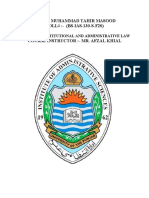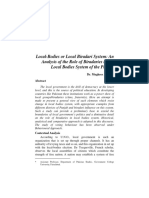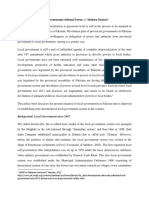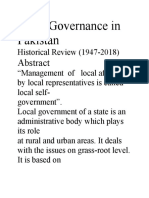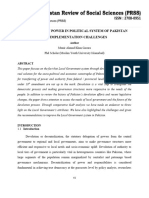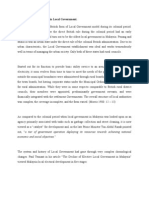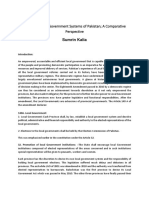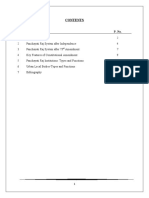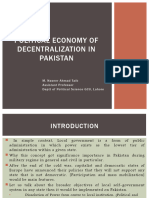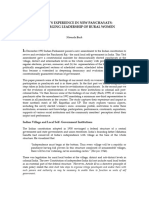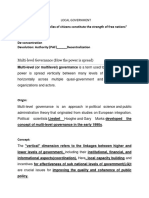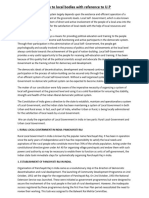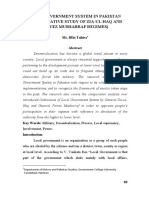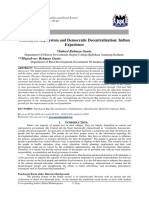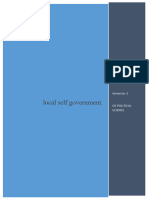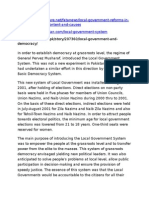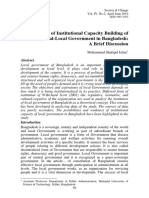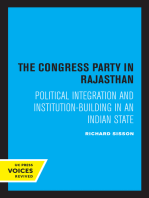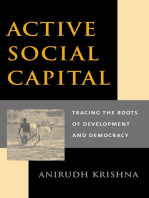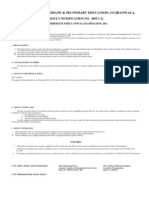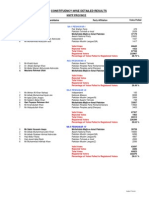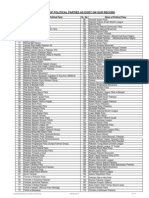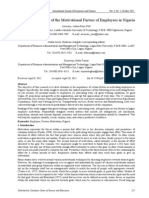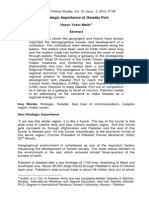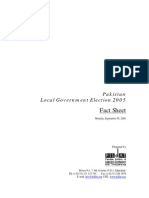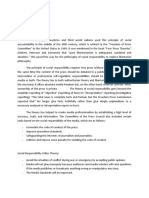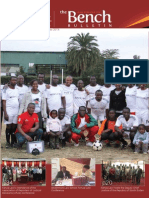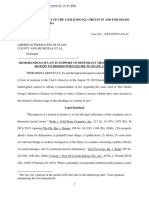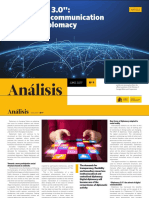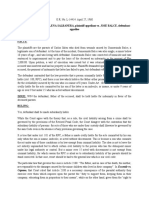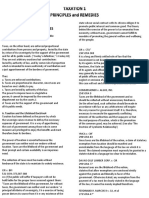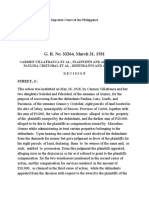Political and Administrative Structure of Local Bodies in Pakistan A Case Study of City District Government Faisalabad
Political and Administrative Structure of Local Bodies in Pakistan A Case Study of City District Government Faisalabad
Uploaded by
Muhammad Ahmad WarraichCopyright:
Available Formats
Political and Administrative Structure of Local Bodies in Pakistan A Case Study of City District Government Faisalabad
Political and Administrative Structure of Local Bodies in Pakistan A Case Study of City District Government Faisalabad
Uploaded by
Muhammad Ahmad WarraichOriginal Description:
Original Title
Copyright
Available Formats
Share this document
Did you find this document useful?
Is this content inappropriate?
Copyright:
Available Formats
Political and Administrative Structure of Local Bodies in Pakistan A Case Study of City District Government Faisalabad
Political and Administrative Structure of Local Bodies in Pakistan A Case Study of City District Government Faisalabad
Uploaded by
Muhammad Ahmad WarraichCopyright:
Available Formats
Berkeley Journal of Social Science Vol.
2, Issue 6-7, June-July 2012
Political and Administrative Structure of Local Bodies in Pakistan A Case Study of City District Government Faisalabad
Saadia Saleem Mughees Ahmed
Abstract Pakistan has a poor data of democracy as for more than half of its years of existence after independence. It has been governed by the military. While the Military governments always created faults with the politicians. It was the basic reason; the Military Government always shaped the Local Government systems as per their own desires to prolong their regimes. Pakistan had experienced with two systems of Local Government before the present Devolution Plan. Historical, analytical and comparative approach is adopted in this discourse. Here an attempt is made to present a general view of such elements which resist change in local bodies system.
Key Words: Nazim, Naib Nazim, Tehsil, Zila
Contextual Analysis: Local institutions means sub units at the public level to which the government gives some authorities so that, they may be able to solve the local problems with the local resources.1 Local Bodies are a system of Government which provides the facilities to the people in specific areas but in Pakistan it is still in experimental stage.2Laski says, we cannot realize the full benefit of democratic government unless we begin by the admission that all problems are not central problems and that the results of problems not central; in their incidence require decision at the place and by the persons where and by whom the incidence is most deeply felt.3 Historical Notes: The history of Local Government elections inside Pakistan was started from the regime of General Ayub Khan (1959-1969). In 1959, he issued an Ordinance through which non-party Local Government Basic Democracy elections were held.
Basic Dem ocracies introduced
M.Phil. Scholar, Department of Pakistan Studies Government College University, Faisalabad. Chairman, Department of Political Science & International Relations. 1 Ahmed,Mughees Local-Bodies or Local -Biradari System: An Analysis of Role of Biradari in Local Bodies System in Punjab., Vol. XXX, No. 1, ISSAN 10127682, (Jan-June 2009), NIHCR. Islamabad, P. 81 2 Azam, Muhammad Chauhdary, (2005). Local Governments: Abdullah Brothers, Lahore; p.70.
Muhammad Asif Malik, Local Self Government in Pakistan, Lahore; Publishers, Emporium, 2006, p .16.
Berkeley Journal of Social Science Vol.2, Issue 6-7, June-July 2012
the Local Government system in Pakistan but Basic Democracy system was destined to become less a means of local representation and more an arm of the bureaucracy.4
At the lower level the Local Government is a drill of democracy, and is the source of political education. In developing countries like Pakistan these institutions represent the powers of Local groups. Zia-ul-Haq, after coming into power, reviewed the system of Local Government and established this system on strong footings, which progressed step by step. 5 Local Government Ordinance (2001), Devolution Plan set up the National Reconstruction Bureau as a think tank. Its mission was to establish the real democracy in the country with the help of reconstructing the institutions of state. District Government, Town Councils, Union Councils, Village Councils and Citizen Community Boards wereplanned by the National Reconstruction Bureau. The District Assembly, the Nazim, the District Administration, the District Police, District Public Safety and Justice Committee formed the District. Chairmen of all Union councils in a District formed the District Assemble.6
City District Government, Faisalabad Structural Analysis
Devolution Power Plan was presented by Pervez MusharrafIn 2000. This was the policy for the reconstruction of Local Government. It was a plan to transfer the Devolution of Power and
Mahmood, Safdar,( 2000). Pakistan: Political Roots and Development 1947-1999. Oxford University Press; p. 79.
5
Jalal, Ayesha, (1995). Democracy & Authoritarianism in Pakistan: A comparative and historical perspective. Lahore: Sang-e-
Meel; p. 99. Callard,K.(1975).Pakistan: A Political Study. London: George Allen and Unwin; p.70. Talbot, I. (1998). Pakistan, A Modern History. New York: St. Martins Press; p.10.
6
Rizvi S A (1976). Changing Patterns of Local Govt. in Pakistan, A study in clashof ideas. IST Ed. Ideal Packages,
Karachi; pp. 28,38, .andSiddiqui, K. (1992). Local Government in South Asia, Dhaka: University Press Limited; p. 67.
Berkeley Journal of Social Science Vol.2, Issue 6-7, June-July 2012
Responsibility to the grass root level. The basic principle of the Devolution Plan was that Local Government would function clearly within the provincial framework.7 For the strong Local Government system, the Provincial Local Government Ordinance, 2001 was included for the period of six month in the Sixth schedule of the Constitution. This ordinance can be amended by the president after discussion with the Prime Minister. Though the Devolution of Power & Responsibility and decentralization of authority was permanent development and convincing improvement in the delivery of services at the District level, would increase the image and efficiency of governments at the grassroots level .Because it was a important element of a good governance to provide a justice at the doorstep. The Local Government was based on five ground rules:
Devolution of political power Decentralization of administrative authority Deconcentration of management functions, Diffusion of the power authority nexus and Distribution of sources.
This plan gave the guarantee of the rights of the people and their participation in the community welfare. Provincial Local Government Ordinance, 2001 provided the framework for the Local Government in Faisalabad. This Local Government system introduced democracy at the grassroot level to serve as the foundation on which we could build the genuine democracy. Due to which power was given to the peoples representatives at all levels. The administrative setup was connected with responsibilities. These clear responsibilities provided protection against political interference. The administration worked under the elected head of the District because the effective check and balances was an integral part of the Local Government plan. Till the
Rafi Khan S (2004).
Pakistan under Musharraf (1999-2002)Economic reformand Political Change, Vanguard
Islamabad; p. 19.
Berkeley Journal of Social Science Vol.2, Issue 6-7, June-July 2012
beginning of existing legal changes, the Constitution of Pakistan did not distinguish Local Government as separate tier of Government with their own powers and functions.8 This Local Government was shaped particularly to fulfill the requirements of the Districts. Local Governments was formed at three levels: District, Town and the Union. District government was consists of District (Zila) Nazim and District Naib Nazim, an elected body and its administrative structures. For the more active participation of the people in community development a grass roots organizations were established such as Village Councils / Neighborhood Councils and Citizen Community Boards. The overview of the distribution of basic structure of the set up of District Government is given in the below diagram.
1st tier 2nd tier 3rd tier
District
Tehsil
Tehsil
Union Council
Union Council
Union Council
Union Council
Village
Village
Village
Village
Source: National Reconstruction Bureau, 2001
Figure: I
The present Local Government system was introduced in 2001, for developing the democracy for strong supremacy and another objective was to transfer of power to the representative of people. For this purpose National Reconstruction Bureau (NRB) was
Local Government Plan, 200, National Reconstruction Bureau, Government of Pakistan.
Berkeley Journal of Social Science Vol.2, Issue 6-7, June-July 2012
established on 18 November, 1999. This Bureau was working on restoration of institutions that were shaped under the Local Government system. 9 The Devolution Programmed in Pakistan was established in five phases. During these phases elections were started from the smaller Districts towards the larger Cities and Districts. It was believed that each phase would improve the implementation of every coming phase. In the first phase the elections were held on 31st December, 2000 in the eight District of Punjab, Three District of Sindh and four District of K.P.K.and three District of Baluchistan. In the second phase the Local Bodies elections were held on 21st March, 2001 in the nine District of Punjab, five District of Sindh, five District of K.P.K. and one District of Baluchistan. In the third phase the Local Bodies elections were held on 31st May, 2001 in District of Punjab included Faisalabad District, two District of Sindh , one District of K.P.K. and five District of Baluchistan. In the fourth phase the Local Bodies elections were held in July 2001in the District of four Provinces and in fifth phase this elections were held in December 2001 in all provinces.10 The election in Faisalabad Division was held in third phase of the Local Body elections. Elections for the Union Councils were held on 31st May 2001, and for the District Government were held on 2nd and 8th August 2001. This election was conducted by the Chief Election Commissioner in pursuance of the Local Government Elections Order, 2000. President appointed him under Article 213 of the constitution of Pakistan. The blue print of Local Government was announced by the Chief Executive of Pakistan on 23 rd March, 2000, and final plan was announced on 14th August, 2001. In Faisalabad the elections of District Council was held on 8th August 2001. Local Government structure was to be put in place by 14th August 2001.This period post 14th August is called Transition Phase. This phase was for the proper transfer of power in the newly established District Government in Faisalabad.11 The transition process was important in ensuring the success of Devolution from the existing system to the New Local Government system. This phase needed the careful planning
National Reconstruction Bureau, 2001. Khan S R (2004). Pakistan under Musharraf (1999 2002). Economic reform and political Change. IST Ed. Vanguard Book: Islamabad; p. 12. 11 Sindh/ Balochistan/North West Frontier/Punjab Local Government Ordinance 2001.
10
Berkeley Journal of Social Science Vol.2, Issue 6-7, June-July 2012
and better approach to implementation. The Provincial Governments established transition teams at the Faisalabad City at District level to ensure a smooth and trouble free operation. The National Reconstruction Bureau (NRB) provided an initial set of transitional guidelines to Faisalabad Governments on February 22nd, 2001. But dueto changes in the law and a number ofdevelopment processestaking place, another transitional guideline was releasedon 14th June, 2001.12 The transition phase preparations completed on 11th March, 2001 when the NRB gave presentations to the Faisalabad Transition Teams. This included guidelines for collecting data through the National Reconstruction Information Management System (NARIM) data collection forms. These guidelines for the District Transition Reports were given on 15 June, 2001. For Faisalabad District Rs.47.5 million were approved for the transition process. This amount was broken up and Rs.45, 000 was given to each Union Council and Rs. 10.5 million was given to the District. The key objectives of the transition process were:
Ensured continuity of services during the transition phase Ensured that staff, facilities and logistics were identified Access funds for the transition period which was provided by the Federal Devolution Fund Ensured that the transition should be take place at a minimum cost. Ensured the improvement of services during the transition phase.
According to this plan the distribution of functions of the District Government is given in the table: Responsibilities of District Government Responsibilities
Education
District Government
Primary &Secondary Education, Literacy
12
Niazi, M. A. ( 1994) . Local Bodies; the history, The Daily News on Friday, 30th September.
Berkeley Journal of Social Science Vol.2, Issue 6-7, June-July 2012 Health Roads Water Sewers & Sanitation Fire Services Parks & Playgrounds Animals Cultural & Sports Services Street Services Dispensaries & Local Hospitals District Roads Water Supply System Yes Yes Yes Slaughterhouses, Fairs Fairs, Cultural Events Street Lighting, Signals
Source: National Reconstruction Bureau,2001Table:
Key:
Yes = responsibility of City Districts
3.1. Political structure & system
Since August 2001 it had been a period of transition as well consolidation. The Local Government representative and elected Nazims relationship with MNAs/MPAs was very difficult one. Much heartburn was created due to this new political structure. The Local Government ordinance, 2001 had developed political power and decentralized administrative and financial authority for good governance and effective delivery of services through institutionalized participation of the people at grassroots level.13
13
Cheema A, Khaja I A and Qadir A (2004). Decentralization in Pakistan: Context, Content and Causes. Kennedy School
Working Paper Number: RWP05-034.
Berkeley Journal of Social Science Vol.2, Issue 6-7, June-July 2012
Political Decentralization Indicators:
Indicators Political Decentralization
Sector
Macro( Local)
Importance of elected bodies in sector policy formulation
Multi-part elections
Local
Government
Elected Local Governments Secret ballot in Local elections Impartiality of the Judiciary Elections held at regular intervals Election free and fair
Importance of elected bodies in sector service delivery
Importance of elected bodies in decisions about levels of sector funding
Source: Charlton, Jackie et al., 2002
Table: 2
The dominating ideology in a society played an important role to understand the structure of the political system at national as well as Local level. Local Body system had linked with Local biradaries. This relation played an important role during general elections and influenced the result at Local level. Andrew Wilders opinion on Local Bodies and its role:
The 1985 National and Provincial Assemblies elections demonstrated that Local Body politics had become the entry point into Provincial and National politics. According to one press account 124 of the 240 members elected to the Punjab Provincial Assembly were sitting members of Local Body. It meant that Provincial and National politics began to resemble Local Body politics. Patronage politics became the order of the day, and representing personal and constituent interests became much more important for legislators than
Berkeley Journal of Social Science Vol.2, Issue 6-7, June-July 2012 representing national interests and this put the PPP, which had not actively participated in Local Body politics, at a severe disadvantage.14
The social system of Faisalabad was dominant by caste system. Local identities and local issues were the part of the politics of Faisalabad. Their political loyalties were attached with their family and biradari. In Faisalabad political parties except Muslim League (N&Q)had not been taking interest in Local Bodies election but they take part in the election of of 2002 in forms of group with different names. Millat Party ( Sher Dad Group), Jamat Islami ( Ihtsaab group), PML-N ( Quaid-i-Azam group), Pakistan Awami Tehreek( Awami group) , PML- HK (Istehkam-e- Pakistan group) , Tehreek Insaf ( Insaf group) and more than 80% male and female candidates were directly attached with political parties their loyalties was related with their political parties. In Faisalabad these Local Groups became active and participated as a representative of political parties during general elections of 2001.
Results of the Elected Representatives for Faisalabad District
Place Faisalabad District Faisalabad City Town Samundari Town Tandlian Wala Town Jhumra Town Jaranwala Tehsil Sadar Nazim Ch. Zahid Nazir Mumtaz Ahmad Cheema Rana Farooq Saeed Ali Gohar Fawad Ahmad Cheema Major(R)Abdul Rehman Rana Misbah-ud-Din Zagham Naib Nazim Muhammad Afzal Sahi Muhammad Ilyas Ansari Abdul Hameed Shamsher Haider Watoo Tariq Mehmood Rai Nasir Hussain Dr. Yasin Votes 2596 797 255 223 152 350 466
Source: Dawn, August 2, 2005
Table: 3
In August 2002, the District Government of Faisalabad was consists of District Nazim, District Naib Nazim, and the District Administration. The Naib District Nazim was the speaker of the District Council and the District Nazim was notthe member of the Council. The Provincial Government interfered in the elections of District Nazims because the seats of Nazim were distributed between the major biradaries and these biradaries were in the majority in the District . So this biradari system had a major say in the political arena of Faisalabad.
14
Wilder, A. R.(1999). The Pakistani Voter: Electoral Politics and Voting Behavior in the Punjab. Karachi: Oxford University Press; p.133.
Berkeley Journal of Social Science Vol.2, Issue 6-7, June-July 2012
The basic part of the Local Government political system and structure formed by the election at Union level. At that level the election were held directly. The direct elections in a Union not only shaped the Union Council but also directly elected District Nazims and Naib Union Nazims.15
Total number of town wise elected seats in city District Government Faisalabad
S# Name of the Town
No. of Union
Total No. of Councilors
Total No. Of Councilors of in all Union Councils in the Town 195 741 364 364 533 559 507 494 3757
Councils in the Elected Town 1 2 3 4 5 6 7 8 Chak Jumera Jarranwala Tandianwala Sumundri Madina Iqbal Jinnah Lyallpur Total Town Town Town Town Town Town Town Town 15 57 28 28 41 43 39 38 289
each Union Council 13 13 13 13 13 13 13 13 13
Source: National Reconstruction BureauTable:
The District Nazim and Naib Nazim elected as joint candidates through the vote of Nazim and Naib Nazim of all Union Councils of a District. There was seats reserved for 5% for Peasants/ labourers, 33% for women and 5% for minority candidates. In fact the Decentralization process was based on the concept of contributory. The goal of the system was that the actual problems of the people would be solved at their doorstep and this thing would improve the quality of governance. Although the Local government brought the significant change in the performance of elected representative because the local councils
15
Ahmad Sultan, ( 1997), Public Administration: With Special Reference to Pakistan. Lahore: Famous Books; p.339.
10
Berkeley Journal of Social Science Vol.2, Issue 6-7, June-July 2012
monitor their performance and holding of the second term elections on time was a clear indication of the acceptance of the system and support of the Government by the people.16 Total No. of Women Seats in the 8- Towns in the District = 96 Total No. Of Women Seats in the Union Council = 96
Total No. Of Women Seats of Councils in the City District =1156 Total No. Of Women Seats in the City District=1348
The election at the Union level formed the backbone of the political system and structure of Local Government of Faisalabad. AT that level election was direct .This direct election formed the Union Council. Each Union Council was consiss of 26 elected members. Out of these 26 were general seats, 8 seats for males and 8 seats for females. Nazim was the head of the Union Council. Union Council were extended to Urban areas in the District for the equal participation of Local representative of political parties. This thing equalized the level of Local representation presented to Urban and Rural areas. AT the District level Nazim and Naib Nazim of all the Union Council elected the District Nazim and District Naib Nazim. Similarly this electoral college elected peasant (5%) , women (33%) and minority candidates. The New set up of Local Bodies working under Punjab Local Govt. Ordinance 2001amended 2005 which came into force w.e.f.14-08-2001. Previous Local Bodies were working under Punjab Local Govt. Ordinance 1979 which is repealed now.In the New Local Council System 5City Districts in the Punjab had been declared.
DETAIL OF COUNCILS IN THE CITY DISTRICT GOVT. FAISALABAD
Local Govt. Election Held on 25-08-2005
Union Council Faisalabad
Election of City District Nazim Oath Taking of City District Nazim Election of Naib Nazim City District
16
06-10-2005. 17-10-2005 28- 12-2005.
Siddiqui, A (2000). Local Self Government. IST ed. Ever- new Book Palace, Lahore; p. 150.
11
Berkeley Journal of Social Science Vol.2, Issue 6-7, June-July 2012
Run of election of Naib Nazim City District Oath Taking of Naib Nazim City District
19-01-2006 23-01-2006
Composition of Union Council City District Govt. Faisalabad
Total No. of 33% Special Seat Lady Members of Union Council Total No. Of 5% Special Seat Peasant / Labour Members of Union Council Total No. Of 5% Special Seat Minority Members of Union Council Total No. Of Union Council Members 96 14 14 413
Town wise detail of members of Union Council Faisalabad
S# Name Town of the No. Union Councils Of No. Lady of No. of Peasant No. /labour Minority of Members Of Total No. Of Members of
members of Members Union
of Union Council
Union Council Union Council in the Town in the Town
Council in in the Town the Town 1 Chak Town 2 Jarranwala Town 3 Tandianwala Town 4 Sumundri Town 5 Madina Town 6 Iqbal Town 7 Jinnah Town 8 Lyallpur 38 13 02 39 13 02 43 14 02 41 14 02 28 09 01 28 09 01 57 19 03 Jumera 15 05 01
01
22
03
82
01
39
01
39
02
59
02
61
02
56
02
55
12
Berkeley Journal of Social Science Vol.2, Issue 6-7, June-July 2012 Town Category Total Wise 289 Nazims 96 Lady 14 Peasant/ Labour 14 Minority Members 413
Source: National Reconstruction Bureau
Table: 5
Although political decentralization was fairly completed by various principles and election were held in a free and fair manner but the following issues have been identified in the set up and its implementation in District Faisalabad.17
Conclusion
The system of Local Self -Government had its strengths and weaknesses. This system offered many opportunities and it faced a number of pressures. Through this system, for the first time many significant elements had been made separately from linking checks and balance. Various levels of Local institutions had elected thousands of men and women for organization the smooth function of Local Self -Government. The Local Government Ordinance gave them powers to make important decisions which dealt not only with Local Government functions but also the Annual Development Programs. This plan set the agenda for Decentralization and the Devolution of power while the real test was with its implementation. The purpose of any democratization process was to bring people closer to Government. Due to that they got knowledge about their fundamental rights. After that they could be able to manage their own cultural, economic and political affairs in a society. Faisalabad District had the exceptional position of having almost all its Union Councils with their particular Citizen Community Boards. These would be important to ensuring community participation and development. It would be up to District, Tehsil and Union Administrations to make ensure that an enabling working environment was created for the development of Local Development. It was necessary to give the space and time to this system to become mature. This thing required great patience, understanding and a change in behavior at
17
Paracha, Saad Abdullah, (2003). Devolution in Pakistan: Context,implementation and issues. Available at:
www.policy. Hu/paracha.
13
Berkeley Journal of Social Science Vol.2, Issue 6-7, June-July 2012
all level. It was not possible to de-construct the building blocks of a system that was 150 years old and start a-new. At once the Improvements in Local service delivery, decision making and governance were not impossible. A start had been made and it must be fulfilled its potential in Faisalabad District and Pakistan. The necessary processes that had been put in place would ensure that Local Government was transparent and accountable to people. There was confusion about exactly how many of the processes and systems would operate. But at least it was a start. Small steps had been made in the process in the improvement of this system. Due to continued support and vision Local good governance may be achieved. Although it were very early days, it was important to realize that unless closely monitored and controlled, the difference of likelihood
between the District Nazim and Tehsil Nazims could be on surface, which could destroy the system. These differences had their roots in party political loyalties. In the election of Local self Government, Pakistan Muslim League supported the District Nazim. The PPP and Jamaat-IIslami supported three Tehsil Nazims. Training and capacity played an important role in successfulness implementation of this program. The implementation of change and performance management, financial management and fiscal decentralization would be impossible if deal with these many complicated issues. At the community level there would be a need for continuous training and strengthening of Citizen Community Boards. The system would fall or succeed by performance of community. There was anxiety and disappointment at the community level. For this purpose federal and provincial governments released funds for District governments. Faisalabad District had Union Councils in their respective Citizen Community Boards. These would be crucial to make possible the community participation and development. It would be up to District, Tehsil and Union Administrations to ensure that an enabling working environment was created for the smooth running of Local development. Institutional reform is a time strong and difficult process. All stakeholders should accept this fact. Because stability is the key to success, it must be giving them a appropriate process which would make possible continues monitoring and troubleshooting of the process. Political reform process should continue. Political Uncertainty position should be ended. proper qualified staff were not provided to
14
Berkeley Journal of Social Science Vol.2, Issue 6-7, June-July 2012
Special focal point should be on women councilors so that they played significant role during the political development. Mechanisms should be established for creating connection between different political tiers of Local Government. Special training should be for elected councilors .Better understandingshould be about working of councils. Individual capacity building should be developed. Public project should be under District Government instead of Union Council. Focus on rights & duties of council. Effective media campaigns shouldbe forvoters political education. Election Commission should have a proper system for voting in polling stations. Systematized database should be updated for electoral roll. Affective arrangements of ID cards Systematized arrangements for holding Local Government election. Nazim should be elected through direct election to finish the political and related pressures. Clarification of roles & responsibilities and reporting channels should be clear for the administrative process.Transfers and postings should be stopped. Focused on mechanisms for training of the government officials at alltiers of Local Government level for better understand Local Government system. Scheduled meeting should be at least once a month for better coordinating between elected representative and officials. Establishment and strengthening National and Provincial Public Safety Commission and police should be under District Government at regional level.
15
You might also like
- SohrabDocument31 pagesSohrabMuhammad Ahmad Warraich100% (2)
- Con Law FlowDocument12 pagesCon Law FlowBrian Palmer100% (7)
- Local Govt of PakistanDocument12 pagesLocal Govt of PakistanMuhammad AliNo ratings yet
- Biradrism & Local-BodiesDocument12 pagesBiradrism & Local-Bodiessibte akbarNo ratings yet
- Local Government System in Pakistan A Historical BackgroundDocument13 pagesLocal Government System in Pakistan A Historical Background03069619063kNo ratings yet
- Kalsoom Policy Brief Local Government Without PowerDocument7 pagesKalsoom Policy Brief Local Government Without PowerKalsoomNo ratings yet
- Decentralization Reforms in PakistanDocument11 pagesDecentralization Reforms in PakistanZulkifl HaiderNo ratings yet
- Local Self Government in PakistanDocument163 pagesLocal Self Government in PakistanabdulbariNo ratings yet
- Devolution of PowerDocument19 pagesDevolution of PowerFozaib ali samraaNo ratings yet
- Local Government System in Pakistan A Historical BackgroundDocument14 pagesLocal Government System in Pakistan A Historical BackgroundUsama hameedNo ratings yet
- The Historical Perspective of L.G in PakDocument11 pagesThe Historical Perspective of L.G in PakAsif IqbalNo ratings yet
- Chap# 3 NotesDocument8 pagesChap# 3 Notesdyqt7vpbdkNo ratings yet
- Class Work On LSG in PAKDocument13 pagesClass Work On LSG in PAKaa2713611No ratings yet
- Research PaperDocument19 pagesResearch PaperAisha UbaidullahNo ratings yet
- 41 The Role of Local Government System in South Asia A Case Study of PakistanDocument14 pages41 The Role of Local Government System in South Asia A Case Study of PakistanPoo KhanNo ratings yet
- Local Govt System A Case StudyDocument34 pagesLocal Govt System A Case StudySelene Khan Jadoon50% (4)
- Project, Basics of LegislationDocument18 pagesProject, Basics of LegislationNAVEEL ISLAMNo ratings yet
- prof._jagan_nath_and_prof._mahajan_final_p.hd_synopsisDocument55 pagesprof._jagan_nath_and_prof._mahajan_final_p.hd_synopsisgautamayush2024No ratings yet
- Local Government: MalaysiaDocument13 pagesLocal Government: MalaysiaBima Buwana100% (8)
- Traditional Structures in Local Governance For Local DevelopmentDocument49 pagesTraditional Structures in Local Governance For Local DevelopmentSean MannNo ratings yet
- Provincial Local Government Systems of Pakistan A Comparative PerspectiveDocument14 pagesProvincial Local Government Systems of Pakistan A Comparative PerspectiveSmart EducationNo ratings yet
- Rural Local GovtDocument5 pagesRural Local GovtPrashantNo ratings yet
- Reform in LGDocument20 pagesReform in LGzam100% (1)
- Local Government: Constitutional Vision and Present PracticeDocument20 pagesLocal Government: Constitutional Vision and Present PracticeRah-ul Ranj-an S-ahNo ratings yet
- Anikesh Gupta Political Science ProjectDocument11 pagesAnikesh Gupta Political Science Projectanikeshgupta30decNo ratings yet
- Topic Number 9 - Organization of Provincial and Local GovernmentDocument6 pagesTopic Number 9 - Organization of Provincial and Local GovernmentalikhanNo ratings yet
- Devolution Plan of General Pervez Musharraf 2001Document6 pagesDevolution Plan of General Pervez Musharraf 2001Humaira Khan100% (2)
- Hisrory AssignmentDocument14 pagesHisrory AssignmentAvantika SahniNo ratings yet
- IJHSS - Scientific and Political - Anup Padhan - OPaidDocument16 pagesIJHSS - Scientific and Political - Anup Padhan - OPaidiaset123No ratings yet
- Changing Contours of District CollectorDocument14 pagesChanging Contours of District Collectorshaan yasirNo ratings yet
- Indian Journal of Public Administration Abstract Oct-Dec 15Document6 pagesIndian Journal of Public Administration Abstract Oct-Dec 15Chander PrakashNo ratings yet
- LSG PPT Dhruv and ShrutiDocument8 pagesLSG PPT Dhruv and Shrutishruti mehtaNo ratings yet
- Local Governmen T System of PakistanDocument63 pagesLocal Governmen T System of PakistanKamran SheraziNo ratings yet
- Political ScienceDocument21 pagesPolitical ScienceAnusha DwivediNo ratings yet
- Pakistan Failure in National IntegrationDocument5 pagesPakistan Failure in National IntegrationAnika AzamNo ratings yet
- Land Law ProjectDocument16 pagesLand Law ProjectNEEL RAINo ratings yet
- Political Economy of Decentralization in PakistanDocument22 pagesPolitical Economy of Decentralization in PakistanKhansaNo ratings yet
- Womens Experience Panchayat SDocument25 pagesWomens Experience Panchayat Syashchaudharyy83No ratings yet
- Local Government Ref With Pol SciDocument15 pagesLocal Government Ref With Pol SciHumayun MirNo ratings yet
- LSG Unit 4Document44 pagesLSG Unit 4smritig1199No ratings yet
- 64 - Tajrean Alam Nili - 121 AssignmentDocument5 pages64 - Tajrean Alam Nili - 121 AssignmentMiitha VaiNo ratings yet
- 5 - Ms. Iffat Tahira PDFDocument18 pages5 - Ms. Iffat Tahira PDFUmairNo ratings yet
- Devolution of Power and Local Bodies Sys PDFDocument58 pagesDevolution of Power and Local Bodies Sys PDFIftikhar farazNo ratings yet
- Panchayati Raj System and Democratic Decentralization: Indian ExperienceDocument4 pagesPanchayati Raj System and Democratic Decentralization: Indian Experienceshreyamanu03No ratings yet
- Assignment of LG PDFDocument15 pagesAssignment of LG PDFstudnt07No ratings yet
- Local Government Laws in Pakistan: Introductory Remarks by Kamran AdilDocument4 pagesLocal Government Laws in Pakistan: Introductory Remarks by Kamran Adilusama jamilNo ratings yet
- Local Government in Pakistan Tool For Legitimacy: A Case Study of Gen. Ayub Khan's BD SystemDocument14 pagesLocal Government in Pakistan Tool For Legitimacy: A Case Study of Gen. Ayub Khan's BD Systemmomin khanNo ratings yet
- Local Government Sir Ali PDFDocument63 pagesLocal Government Sir Ali PDFTahreem FatimaNo ratings yet
- Problems of Local Government in Pakistan and Suggestion For ImprovementDocument20 pagesProblems of Local Government in Pakistan and Suggestion For ImprovementMuhammad faisalNo ratings yet
- My Article in July 2024Document16 pagesMy Article in July 2024Akmal KalyarNo ratings yet
- Forward Karnataka's Panchaya Raj System Decentralised Planning in Karnataka - d-8720Document60 pagesForward Karnataka's Panchaya Raj System Decentralised Planning in Karnataka - d-8720Egov ShimogaNo ratings yet
- Local SelfDocument9 pagesLocal SelfRitabrata KarmakarNo ratings yet
- Syllabus For MA III SemDocument10 pagesSyllabus For MA III SemAakrati TiwariNo ratings yet
- 016 - Local Government System in Bangladesh - An Assessment (96-108) PDFDocument13 pages016 - Local Government System in Bangladesh - An Assessment (96-108) PDFKM GALIB DAUD100% (1)
- Democracy/: Pakistan-Context-Content-And-CausesDocument5 pagesDemocracy/: Pakistan-Context-Content-And-CausesAbid RazaNo ratings yet
- Political Instability in Pakistan - Essay For CSS ExamsDocument4 pagesPolitical Instability in Pakistan - Essay For CSS ExamsJatoi Akhtar67% (3)
- Pakistan Local Government Profile 2011-12Document4 pagesPakistan Local Government Profile 2011-12Hameed DhananiNo ratings yet
- Basis of Institutional Capacity Building of Rural-Local Government in Bangladesh: A Brief DiscussionDocument9 pagesBasis of Institutional Capacity Building of Rural-Local Government in Bangladesh: A Brief DiscussionA R ShuvoNo ratings yet
- Preface: Objective of The StudyDocument13 pagesPreface: Objective of The Studyashok chauhanNo ratings yet
- The Congress Party in Rajasthan: Political Integration and Institution-Building in an Indian StateFrom EverandThe Congress Party in Rajasthan: Political Integration and Institution-Building in an Indian StateNo ratings yet
- Active Social Capital: Tracing the Roots of Development and DemocracyFrom EverandActive Social Capital: Tracing the Roots of Development and DemocracyNo ratings yet
- Board of Intermediate & Secondary Education, Gujranwala.: Result Notification No. 4895 C.EDocument7 pagesBoard of Intermediate & Secondary Education, Gujranwala.: Result Notification No. 4895 C.EMuhammad Ahmad WarraichNo ratings yet
- Stat KA May2011Document197 pagesStat KA May2011Muhammad Ahmad WarraichNo ratings yet
- Student Loan DetailsDocument2 pagesStudent Loan DetailsMuhammad Ahmad WarraichNo ratings yet
- Toxicity of Pesticides: Government of Sindh, Agriculture DepartmentDocument8 pagesToxicity of Pesticides: Government of Sindh, Agriculture DepartmentMuhammad Ahmad WarraichNo ratings yet
- NA Election Results 2002 NWFP ELECTION RESULTS, Aamir HussainDocument77 pagesNA Election Results 2002 NWFP ELECTION RESULTS, Aamir HussainAamir HussainNo ratings yet
- List Pol PartiesDocument2 pagesList Pol PartiesMuhammad Ahmad WarraichNo ratings yet
- An Empirical Study of The Motivational Factors of Employees in NigeriaDocument7 pagesAn Empirical Study of The Motivational Factors of Employees in NigeriaMuhammad Ahmad WarraichNo ratings yet
- Kit Kat: Revitalizing A Brand Leader: A Nestlé Case StudyDocument5 pagesKit Kat: Revitalizing A Brand Leader: A Nestlé Case StudyMuhammad Ahmad WarraichNo ratings yet
- Strategic Importance of Gwadar Port: Hasan Yaser MalikDocument13 pagesStrategic Importance of Gwadar Port: Hasan Yaser MalikMuhammad Ahmad WarraichNo ratings yet
- Fact Sheet: Pakistan Local Government Election 2005Document4 pagesFact Sheet: Pakistan Local Government Election 2005Muhammad Ahmad WarraichNo ratings yet
- Different HR M Case StudyDocument5 pagesDifferent HR M Case StudyMuhammad Ahmad Warraich100% (1)
- Study On Motivational Factors of Civil Construction Site EmployeesDocument5 pagesStudy On Motivational Factors of Civil Construction Site EmployeesMuhammad Ahmad WarraichNo ratings yet
- 11 - List of Successful Candidates: Andhra PradeshDocument18 pages11 - List of Successful Candidates: Andhra PradeshMuhammad Ahmad WarraichNo ratings yet
- Factors Affecting Employee'S Motivation in The Fast Food Industry: The Case of KFC Uk LTDDocument10 pagesFactors Affecting Employee'S Motivation in The Fast Food Industry: The Case of KFC Uk LTDMuhammad Ahmad WarraichNo ratings yet
- Groups From Whom Para-Legal Volunteers Can Be SelectedDocument2 pagesGroups From Whom Para-Legal Volunteers Can Be SelectedDrishti TiwariNo ratings yet
- 07 Estrada vs. Sandiganbayan G.R. No. 217682Document10 pages07 Estrada vs. Sandiganbayan G.R. No. 217682Annie Bag-aoNo ratings yet
- Social Responsibility TheoryDocument2 pagesSocial Responsibility TheoryAshdown ReyesNo ratings yet
- 1.1 - Introduction To Law and Legal System in Sri LankaDocument39 pages1.1 - Introduction To Law and Legal System in Sri Lanka21UG0740 DESHAN P.P.T.No ratings yet
- Public Relations Review: Kiranjit KaurDocument4 pagesPublic Relations Review: Kiranjit KaurAzizan RamlyNo ratings yet
- Roseville Video Press StatementDocument3 pagesRoseville Video Press StatementGoMNNo ratings yet
- Arrest Case DigestsDocument175 pagesArrest Case Digestsviva_33No ratings yet
- Taxicab Operators VS BotDocument1 pageTaxicab Operators VS BotNaif OmarNo ratings yet
- Bench Bulletin Issue 26Document114 pagesBench Bulletin Issue 26MaryNo ratings yet
- BJ0063 SLMDocument364 pagesBJ0063 SLMArindam SardarNo ratings yet
- Memorandum of LawDocument11 pagesMemorandum of Lawal_crespo100% (2)
- Economic Dimension of EducationDocument45 pagesEconomic Dimension of EducationRizza De Mesa Pavia100% (1)
- Digital DiplomacyDocument5 pagesDigital Diplomacyerice.researchNo ratings yet
- CNS v. Planet, Chief Justices Conference Amicus BriefDocument32 pagesCNS v. Planet, Chief Justices Conference Amicus BriefCenter for Constitutional JurisprudenceNo ratings yet
- Salen vs. BalceDocument2 pagesSalen vs. BalceLuis Armando EnemidoNo ratings yet
- Lladoc Vs CIRDocument2 pagesLladoc Vs CIRNurwisa SamlaNo ratings yet
- Uy vs. CaDocument2 pagesUy vs. CaOrange Zee MelineNo ratings yet
- Taxation Principles and Remedies Finals ReviewerDocument39 pagesTaxation Principles and Remedies Finals ReviewerRamilNo ratings yet
- All State CR.P.C Mains Previous Year Questions: DefinitionsDocument24 pagesAll State CR.P.C Mains Previous Year Questions: DefinitionsNidhi TiwariNo ratings yet
- 2 Madrinan v. MadrinanDocument9 pages2 Madrinan v. MadrinanRozaiineNo ratings yet
- G. R. No. 33264, March 31, 1931: Supreme Court of The PhilippinesDocument8 pagesG. R. No. 33264, March 31, 1931: Supreme Court of The PhilippinesM A J esty FalconNo ratings yet
- Working Paper For The ResolutionDocument3 pagesWorking Paper For The ResolutionAnurag SahNo ratings yet
- Ors. vs. Union of India (1983) 1: Case Analysis: D.S. Nakara and 305Document14 pagesOrs. vs. Union of India (1983) 1: Case Analysis: D.S. Nakara and 305priyaNo ratings yet
- Case Doctrines On Crimpro 110-127 PDFDocument32 pagesCase Doctrines On Crimpro 110-127 PDFJoefranz BiloNo ratings yet
- State of J and K Vs Zia Mustafa and Ors 29102022 JK2022101122170508152COM315615Document4 pagesState of J and K Vs Zia Mustafa and Ors 29102022 JK2022101122170508152COM315615jagan kilariNo ratings yet
- Div 46 Video Games Societal Violence StatementDocument5 pagesDiv 46 Video Games Societal Violence StatementChrisFerguson100% (2)
- Right To Remain Silent PDFDocument30 pagesRight To Remain Silent PDFUsama KhawarNo ratings yet
- Corrections Act: Revised Statutes of Alberta 2000 Chapter C-29Document32 pagesCorrections Act: Revised Statutes of Alberta 2000 Chapter C-29Rodel BassigNo ratings yet


